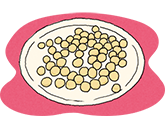Adding low GI foods to your diet
GI is an index, just like counting calories
With its beneficial second-meal effect, the GI can be used as a tool to help you eat more healthily, in the same way that counting calories can help you maintain a healthy diet. You can have low GI foods for breakfast or as a snack to keep your blood sugar level low, or you can add them to your daily diet on a regular basis as a way to combat metabolic syndrome. If it's difficult to find the time to prepare low GI foods, try using soybean nutrition bars in the same way that you would use nutritional supplements.
- *Ministry of Agriculture Home Page
By introducing low GI foods into your daily diet you can slow down the rise of blood sugar levels. The benefits are felt not only immediately after ingestion, but with the "second-meal effect", continue through until after your next meal or snack, helping you live a healthier daily life.
- Low GI foods moderate the rise of blood sugar levels, and thus are recommended for people who are at risk of having diabetes.
- By moderating the rise in blood sugar level, low GI foods reduce the amount of insulin secreted by the body. Insulin converts sugar into fat, and so by suppressing its production low GI foods help prevent obesity and metabolic syndrome.
- Low GI foods keep you feeling satisfied for longer after eating.
- Eating low GI foods suppresses the rise of blood sugar levels after your second meal (the second-meal effect).
- It is important to consider what foods in your diet have a low GI, just as you would count calories.






